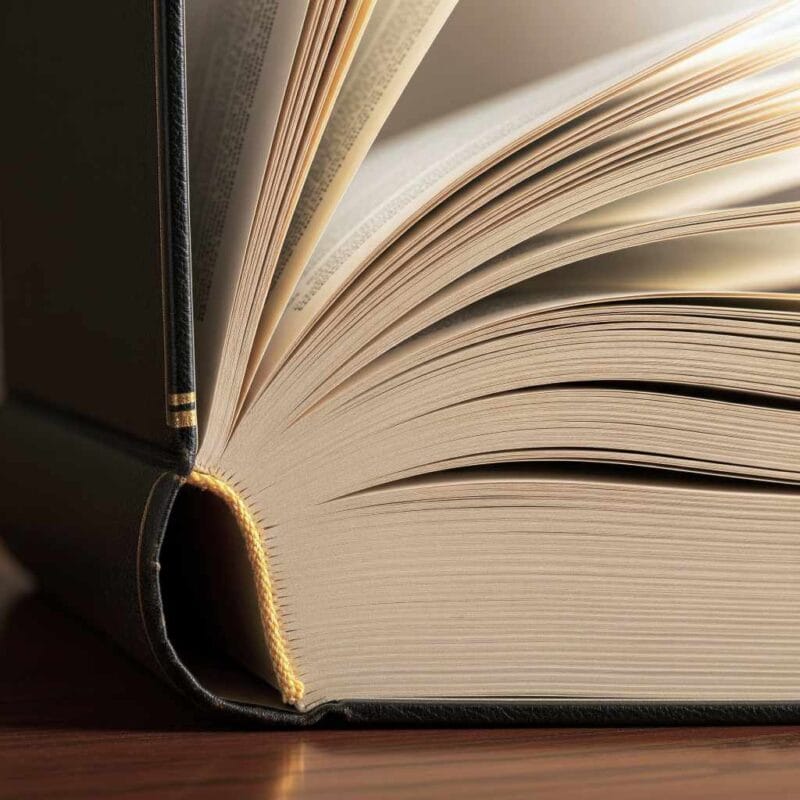- Narrative structure serves as the foundation of storytelling. It guides how a story unfolds and gives form to both the plot and the development of characters.
- Common structures include the Three-Act Structure (setup, confrontation, resolution), Seven-Point Structure (key plot milestones), and Five-Act Structure (a balanced hybrid).
- Nonlinear approaches like the Fichtean Curve and Hero’s Journey add complexity, while circular and frame narratives enrich stories through layered perspectives.
- Key components of narrative structure include:
– Setting and Context: Establishes the backdrop and atmosphere
– Characters: Protagonists, antagonists, and supporting roles drive the narrative
– Plot Development: Links events through rising action and climax
– Conflict and Resolution: Creates tension and closure
– Theme and Message: Encapsulates central ideas - Unlike expository formats, which aim to convey information, narrative structures prioritize story and engagement. They draw the audience into a world rather than simply presenting facts.
Narrative structure plays a fundamental role in creating the overall shape and movement of a story’s flow and logic. It sets the direction of the plot and charts how characters evolve by offering a framework that holds the entire story together. At the same time, authors employ many different techniques, from linear progression to nonlinear storytelling, to create engaging narratives. Structure determines how the audience moves through the story and how meaning unfolds. By learning about narrative structure, readers can come to a new appreciation of the artistry that goes into crafting a story.
What is a narrative structure?
Understanding narrative structure is crucial for crafting deep, complex stories that resonate with readers. Structure provides the framework that organizes the plot and shapes the movement of character development. This structure acts as a roadmap for arranging the story’s plot points and character arcs, which help to maintain an engaging narrative flow and hook. When writers grasp the type of structure they’re employing, they can infuse their storytelling with the richness and subtleties that audiences desire.
Definition of Narrative Structure
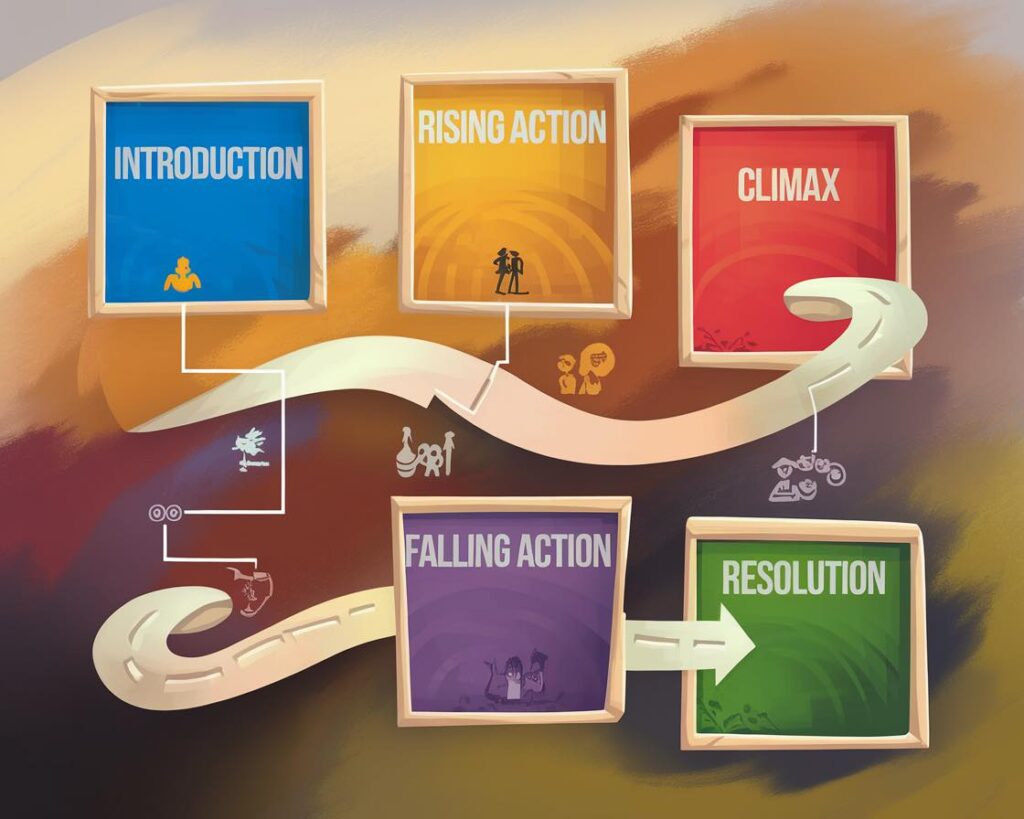
This is why linear narrative structure—the time-honored backbone of storytelling—is so critical to providing shape and direction to a narrative. It encompasses the organized sequence of events, the rhythm of rising and falling action, and the climax that ties the story together. This common narrative structure can be executed in many ways, each appropriate for various storytelling purposes.
The most popular story structure in Western storytelling is the Three-Act Structure, which breaks stories up into setup, confrontation, and resolution. It’s simple, but it makes for a very effective building of tension and development of the storyline.
Moreover, the Seven-Point Structure provides a deep and rich framework for writers. It takes them through key steps like the inciting incident, plot turn, and the midpoint. This particular narrative structure is especially useful for writers who want to create deep, rich, and captivating stories.
For writers looking for balance, the Five-Act Structure provides an alternative. It’s a hybrid of both the Three-Act Structure and the Seven-Point Structure. It breaks stories down into five clear sections, making it easy to flesh out the story in depth.
For hundreds of years, classic story structure has informed best-selling novels and made boxes of visual storytelling. Its compact, cinematic format provides a perfect medium to explore the art of storytelling. Writers who prefer detailed planning often turn to the Snowflake Method, which breaks the process into clear steps and helps establish a strong foundation while avoiding writer’s block
Importance of Narrative Structure in Storytelling
Narrative structure plays a vital role in every story. It acts as a blueprint for writers and helps readers stay connected to the plot. A strong linear narrative captures attention by moving through a clear and exciting sequence of events. For instance, the Fichtean Curve is renowned for its constant rising and falling action, which creates suspense and works especially well in fast-paced genres like film. The Kishōtenketsu Structure, rooted in East Asian storytelling, offers a unique perspective by focusing on contrast and thematic progression rather than conflict.
Aristotle’s Poetics remains one of the oldest texts on story structures, significantly influencing how we perceive narrative mechanics today. This foundational text has guided generations of storytellers and shows that narrative structure lies at the heart of how people tell stories, across cultures and mediums.
Components of Narrative Structure
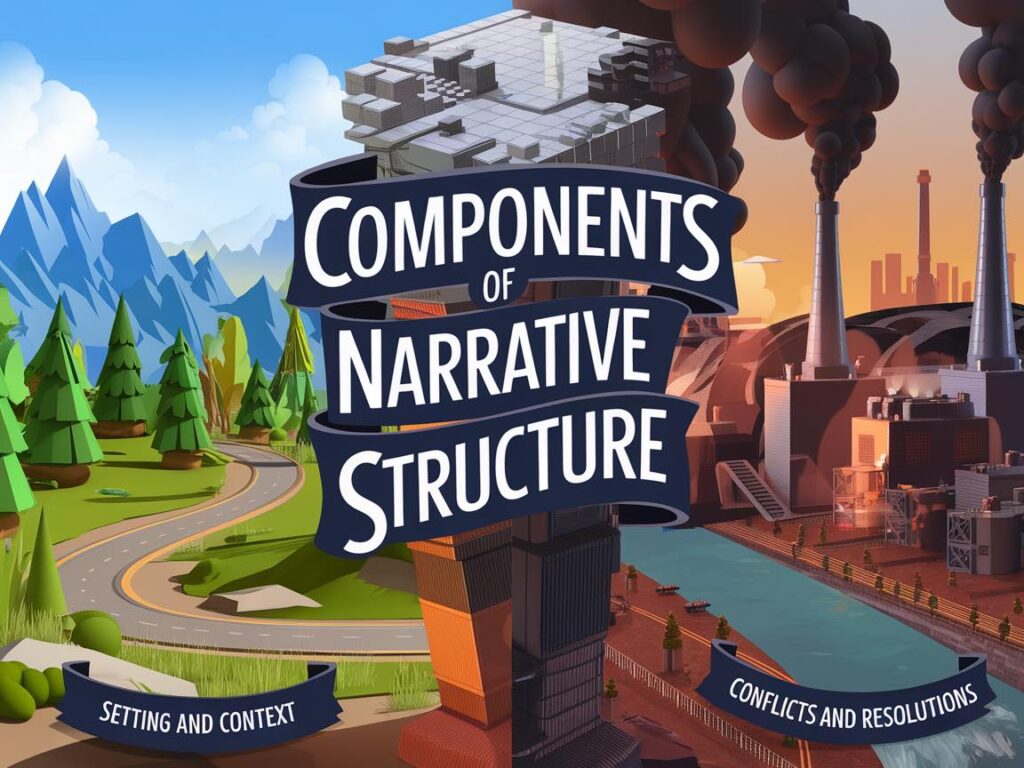
To guide readers through a coherent narrative experience, the narrative structure acts as the fundamental framework of any story. Each element of a narrative text contributes layers and meaning and ensures that the story connects with the audience on intellectual, emotional, and visceral levels.
Setting and Context
Setting and context mark the beginning of every narrative. They establish the environment in which the story unfolds and shape the way characters interact with their world. A vivid setting draws the audience into the story and reveals the social conventions that dictate that character’s behavior. For instance, a narrative set in the crowded streets of 1920s New York creates a mood very different from one rooted in a quiet rural town. These contrasts show how much the backdrop can affect tone, structure, and pacing. Real-life events and cultural context bring texture to the story and add meaning that strengthens its connection to the audience.
Characters and Roles
Characters are the vehicle through which the reader experiences the story, and their function within the narrative experience is key. Protagonists, antagonists, and supporting characters all play different roles within various story structures. Your protagonist can have an inner journey of self-discovery while your antagonist delivers external conflict that drives the action.
Good character development gives readers intricate, multifaceted characters with strong motivations and growth arcs that influence them to relate to and care deeply about their journeys. Atticus Finch from Harper Lee’s To Kill a Mockingbird (1960) exemplifies integrity and justice and serves as a critical link in telling the overarching story’s main themes.
Plot Development
Plot development is crucial to the narrative experience by guiding the reader through a chain of related events. An exciting narrative arc is a delicate dance between exposition, rising action, climax, and falling action, where each step flows seamlessly into the next. Consider how J.K. Rowling’s Harry Potter series expertly weaves together multiple intricate storylines that build suspense and anticipation. Consequently, each narrative thread escalates and culminates in a rewarding payoff. A well-constructed linear narrative creates steady tension and rising anticipation—each event pushes the story forward and keeps the audience eager to find out what happens next.
Conflict and Resolution
Conflict drives every compelling narrative by introducing tension and raising the stakes. Whether internal or external, the challenges a character faces push them to adapt and evolve. Resolution brings the story to a close by addressing its central conflicts and offering a sense of completion. In To Kill a Mockingbird, the trial of Tom Robinson exposes deep social divisions, and its outcome prompts serious reflection. Through the interplay of conflict and resolution, narrative structure becomes a powerful tool for examining human behavior and social realities.
Theme and Message
Themes and messages form the core of any narrative. They offer meaningful reflections on real human experiences and often stay with the audience long after the story ends. These ideas encourage reflection and invite debate over their deeper meanings. Themes such as love, identity, or justice introduce layers of complexity that lead the audience to consider broader social and moral questions. George Orwell’s Nineteen Eighty-Four (1949) illustrates how a well-structured narrative can challenge accepted views. It warns against the dangers of surveillance and forces readers to examine what freedom truly means in the context of modern society.
Types of Narrative Structure
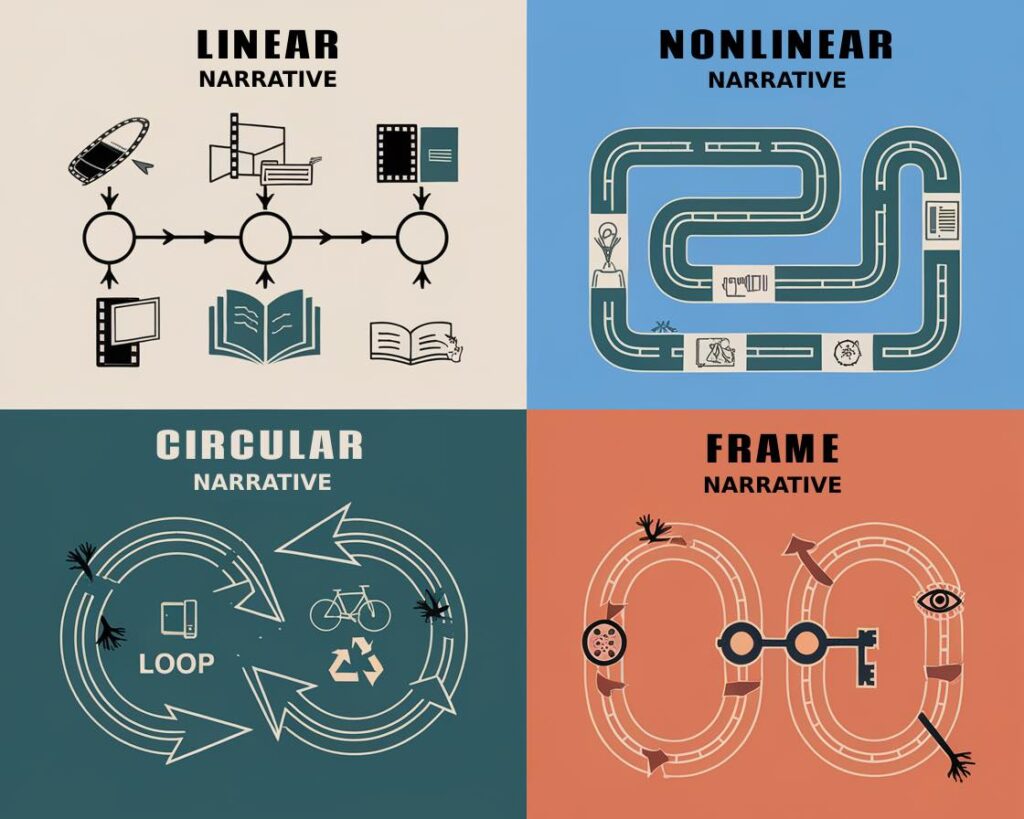
Linear Structure
A linear narrative structure follows a clear path from beginning to end. It works well for stories that rely on a straightforward timeline of events. The Three-Act Structure—divided into Setup, Confrontation, and Resolution—offers a well-defined example. This method does more than organize events; it helps the audience follow the story without confusion. Jane Austen’s Pride and Prejudice (1813) reflects this structure through its precise sequence of developments, each building on the last. Where linear narrative truly shines is due to its crystalline clarity and logic, which makes it ideal for stories striving to convey a strong, focused message.
Nonlinear Structure
At the opposite of the linear narrative structure is the use of nonlinear narrative, which creates a more engaging and complex narrative experience. This nonlinear structure breaks the arc’s chronological flow by frequently employing flashbacks, foreshadowing, or parallel storylines. The Fichtean Curve offers a strong example, as it moves characters through a series of escalating obstacles rather than following a straightforward timeline. David Mitchell’s Cloud Atlas (2004) does a masterful job with this technique by intertwining multiple timelines and perspectives into a beautiful narrative.
Furthermore, the Hero’s Journey shatters the status quo and sends heroes on life-changing journeys, as observed in narratives such as F. Scott Fitzgerald’s The Great Gatsby (1925). Nonlinear structures often deepen narratives through complexity and enrichment, thereby captivating audiences with a rich fabric of intersecting tales.
Circular Structure
Circular narratives, often characterized by a circular narrative structure, return stories full circle, frequently concluding back at the starting point, which adds to the narrative’s closure and completeness. Dan Harmon’s Story Circle exemplifies this popular story structure, as the series takes advantage of a looping structure of events to explore character arcs without making any large leaps. Writers often use this technique in sitcoms, where characters face new situations but return to the same emotional or narrative point by the end. Its predictability becomes part of the appeal, as each episode ends where it began, forming a satisfying and reassuring loop.
Frame Narrative
The frame narrative creates a truly mesmerizing experience by weaving personal stories into a broader narrative perspective, introducing a powerful new layer to the story. This linear narrative structure deepens the overarching narrative by providing contrasting views and additional context. The Freytag’s Pyramid, which was inspired by Greek tragedies, can be adapted into a frame narrative by providing a dramatic arc within the overarching story. Emily Brontë’s Wuthering Heights (1847) uses this technique with striking effect. A central narrator recounts the lives of other characters, creating a blended structure that reveals emotional complexity and subtle shifts in tone.
Comparing Narrative with Other Structures
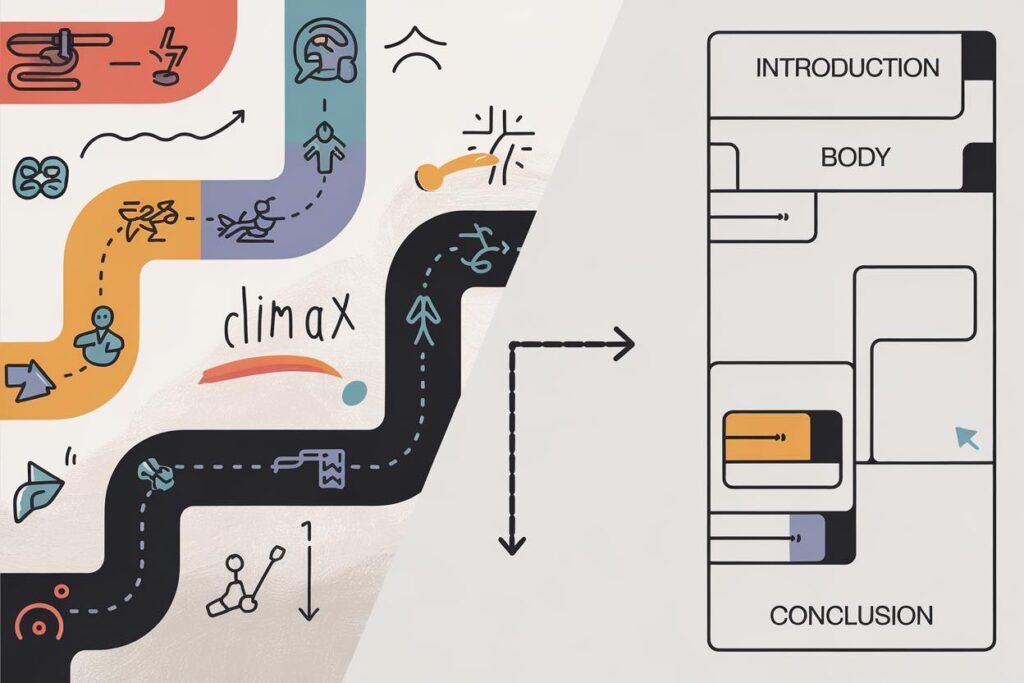
Unlike expository formats, narrative structures draw the audience in through layered character arcs and unexpected turns in the plot. They offer more than a transfer of information—they chart emotional and psychological journeys that keep the story alive. What sets narrative structures apart is their ability to carry the audience through multiple dimensions of the story. When crafted well, their impact lingers well beyond the last page.
Differences with Expository Structure
Unlike expository structures, narrative structures focus on the art of storytelling rather than the relaying of information. An expository structure is ideal for a clear and logical presentation of facts and ideas, often used in textbooks or instructional manuals. It can be a more open vehicle for knowledge transfer absent the emotional heft of a narrative. For example, an expository climate change essay would define the concept of increasing temperatures and provide supporting facts and figures. On the other hand, an example narrative structure might explore the life of a farmer struggling with drought by humanizing the data.
Nonlinear narrative structures like those seen in many contemporary novels and movies build incredible tension. They do this by abandoning the dominant chronological structure. This is in stark contrast to the linear format of expository writing. Shows like Buffy the Vampire Slayer have accomplished this beautifully by intertwining episode-to-episode structure while working in a larger narrative. This technique is uncommon in explanatory prose; writers can build greater anxiety and suspense through non-chronological structure. This technique especially succeeds in films where multiple timelines intersect, like in the tale of Valeria and El Chivo in the 2000 film Amores Perros by Alejandro González Iñárritu.
Similarities with Descriptive Structure
Compared with descriptive structure, the narrative structure does have some similarities, such as a focus on detail and immersion. Descriptive structures aim to engage audiences with rich imagery and sensory detail, often layered throughout narratives to add depth and flair to storytelling. Imagine that vibrant marketplace bursting with energy and creativity—the vivid description of the sights, sounds, and scents creatively places the reader in the midst of the colorful scene. Both structures are designed to paint a picture, stir emotions, and engage the reader on a sensory level.
Narratives and other descriptive structures utilize language intentionally selected to maximize impact and create imagery. They combine states, segments, and incidents similarly to popular story structures like Harmon’s Story Circle. This technique enables the writer to layer experiences and create a beautiful tapestry of emotion and imagery. Both structures require rich, textured language, deepening the reader’s immersion into the narrative, whether it’s exploring a character’s crisis of conscience or laying the groundwork for the dramatic events about to unfold.
Finding the ideal narrative structure for a novel is perhaps the most important decision a writer will make. Readers remain captivated by a well-crafted linear narrative, especially when it combines an intriguing plot and character development.
Creating a Compelling Narrative

In the world of storytelling, creating a compelling narrative experience is like making a beautiful tapestry. It’s a genuine art form that necessitates a meticulous blend of character development, plot development, worldbuilding, conflict presentation, and resolution. This technique not only adds a dramatic hook to the story but also draws the reader in from the outset. Following are the ways to create a compelling narrative structure:
- Develop strong characters: Whether it’s a film, a book, or a short story, strong characters are the foundation of narrative. Characters need to be well defined and authentic, possessing unique voices, personalities, motivations, and character arcs. A well-developed character draws the reader in, igniting the imagination and creating an emotional investment.
- Build engaging plots: A strong plot is the backbone of any successful story, and utilizing popular story structures like the Three-Act or the Seven-Point structure can significantly enhance the narrative experience. Authors and screenwriters alike employ these methods to create a compelling narrative arc that keeps audiences engaged.
- Establish clear settings: A clearly established setting—both in place and time—grounds the narrative arc and shapes a storyline with strong context and atmosphere. When the setting feels as present as any character, it becomes a vital part of the story. It gives the plot dimension and gives the characters a space in which their traits and choices take shape.
- Introduce conflict early: Conflict is the engine that makes the narrative experience run. For fiction writers, introducing conflict right from the beginning is critical to hook the reader and create an emotional connection. Statistics show that 80% of readers will stop reading a book if they don’t become emotionally invested within the first 10% of the narrative. The Fichtean Curve, with its emphasis on ongoing conflict, offers an excellent linear narrative structure for maintaining that tension throughout the story.
- Deliver a satisfying resolution: A satisfying resolution brings the story’s threads to a close and delivers a clear sense of completion. Most importantly, it ties up the main conflict in a manner that’s believable and emotionally rewarding. The chosen narrative structure or shape of the narrative and the use of the Hero’s Journey trope, for example, promise a resolution that completes the protagonist’s journey in a coherent narrative.
Narrative structure, being the spine of a story, takes the reader on a journey that has a distinct beginning, middle, and end. Knowing what constitutes a narrative structure helps an effective writer create stories that hook, intrigue, and compel.
Each type of narrative structure offers a distinct approach to storytelling—writers can choose the form that best fits their purpose. By comparing different structures, you begin to see how each one shapes emotion, rhythm, and meaning in a unique way. These contrasts reveal how structure directs a story’s engagement with broader themes and ideas.
Creating an effective narrative is an art form and a science; with the right tools, the process is empowering and enjoyable. To take a better plunge into this exciting world of storytelling, there’s no better time than now to immerse yourself in novels that make use of these structures. Turn the page and see the transformational power of narrative in action.
Further Reading
Naming the Dog: The Art of Narrative Structure by Christie Aschwanden, The Open Notebook
Puzzling Through Story Structure by Karen Given, Narrative Beat
The Structure of a Story by fs.blog
The greatest chart on narrative structure that you’ll probably see today, but who really knows? on Reddit


